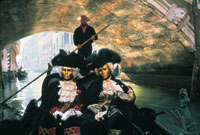 |
||||||||||||||
|
– Errol Laborde, Mardi Gras historian
|
Time To Play!
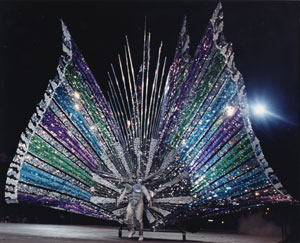
|
|||||||||||||
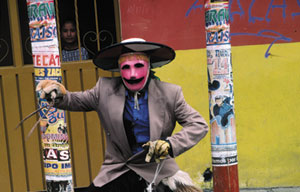 |
Chivarrudo, Tlaxcala, Mexico, 1999. Photograph by Barbara Mauldi |
Playing Mas
Short for masquerade, Mas is how people refer to Carnival in Trinidad and Tobago, even though most participants no longer wear masks. After the ban on Carnival was lifted following World War II, when such play was not appropriate, most masks were traded in, but not the elaborate, full-body costumes. Mas camps, where Carnival costumes are produced, operate year-round. Coveted king and queen costumes can easily exceed $15,000, but most cost several hundred dollars—certainly a significant sum in poorer communities."Carnival is an important earner of foreign exchange, and the state certainly knows that and promotes Carnival to that end. But Carnival is so closely linked to people's sense of identity in Trinidad, there’s no way it can be thought of only in terms of dollars and cents,” says Shalini Puri, a postcolonial theory and cultural studies scholar who focuses on the Caribbean. “Carnival is a glimpsing of abundant creative energy. Many of the arts in the Caribbean are so closely tied to Carnival. It taps the energies of everything and pulls it in."
Many masquerades are drawn from local history. The peliqueiros in Laza mimic 16th-century tax collectors, complete with grimacing faces and whips. In Venice, Plague Doctors drape themselves in long, black capes, white masks, and very long, pointed noses, mimicking the protective masks once worn by doctors treating plague victims. The long noses were allegedly stuffed with herbs and flowers to mask the stench of disease.
The Mardi Gras Indians in New Orleans are African Americans dressed as Native Americans, a tradition that acknowledges Native Americans as fellow outcasts in society as well as a history of claiming to be Indians to escape the most severe segregation laws.
In most countries, we’re not talking about a simple game of dress up. Prizes are well sought after, and in Port of Spain, for example, participants write and deliver unique scripts based on the character they play.
“What’s so radical and interesting about Carnival in Trinidad is that you can be Calypso King one year and pelted off the stage the next year,” adds Puri, referring to a musical title at the center of every Carnival in Port of Spain. “People demand that you remake yourself every year.”
|
|
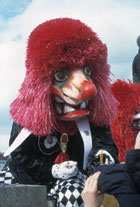 |
Masqueraders in Gondola,
Venice, Italy, 1998.
|
Waggis, Basel, Switzerland, 2001.
|
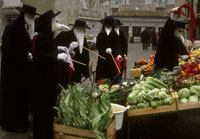 |
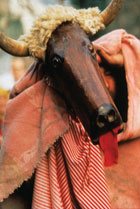 |
Doctor of the Plague Masqueraders in an Outdoor Market, Venice, Italy, 1991. Photograph by David and Shirley Rowen |
La Morena, Laza, Spain, 1992.
|
You Can Feel the Beat—and Sometimes It Stings
At Carnival, the music moves you—literally. And music is a big part of the ¡CARNAVAL!
In Spain and Bulgaria, bagpipes get your feet aflutter. In Brazil, it’s the African-derived drum beats of the maracatu, music distinct to Recife and Olinda. Brass bands and square dancing dominate in Tlaxcala, Mexico, and in the Big Easy, it’s Dixieland, jazz, the chants of the Mardi Gras Indians, and the rolling beats of the high school marching bands.
As Fat Tuesday approaches in Port of Spain, where Carnival is as much a celebration of emancipation as a precursor to Lent, steel band competitions heat up, live soca (blend of soul and Calypso) bands parade, and calypso performers tell it the way it is—often criticizing local and national leaders—while competing for air time and the coveted title of King of the Calypso.
Social and political criticism is at the heart of all Carnival celebrations—in the music, in the costumes, as parts of parade floats. Each year in rural Laza, the “testament of the donkey” is read aloud, detailing the town’s scandals over the past year. In Basel, recently, some 200 lanterns stood as a symbol against the war in Iraq.
Everyday life has long influenced Carnival and vice versa. And that tradition continues today. In 1990, during a coup attempt in Port of Spain, an evening curfew was put in place to prevent public gatherings. “People started having curfew parties,” notes Puri, “and that’s definitely a Carnival-influenced, political response.
“Under the threat of gunfire, they are dancing.”
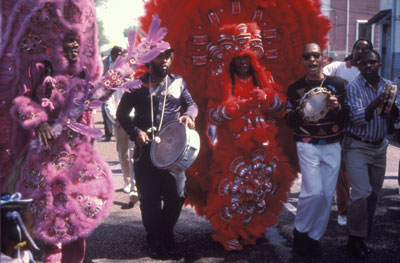 |
Mardi Gras Indians, shown above, are African Americans dressed as Native Americans, a tradition that acknowledges them as fellow outcasts in society and a history of claiming to be Indians to escape the most severe segregation laws.
|
New Orleans: “Masking Is Part of Us”
In 2006, New Orleans’ Mardi Gras made a bold statement to the world. It was affirmation of survival just six short months after Hurricane Katrina ravaged the city, killing more than 1,300 of its residents and flooding 80 percent of town—all while the rest of the nation and the world watched the misery unfold on television.
While many outsiders, and some locals, believed the last thing New Orleans needed was a massive party with unruly crowds, the Times-Picayune declared that “masking is part of us.” And a warm, sunny Mardi Gras drew some 600,000 visitors, a leaner Fat Tuesday than in years past, but a remarkable showing considering more than half of the city’s hotel rooms were still filled with relief workers.
“The point of Carnival last year was to say New Orleans survived, we’re alive and culturally here, and with not much thanks to anyone else,” says Judy Maxwell, assistant professor of anthropology at Tulane University. “It was the city in solidarity with itself.”
Some local leaders initially flip-flopped over a post-Katrina Carnival, but it was Zulu Social Aid and Pleasure Club, the city’s largest and predominantly African-American Carnival “krewe,” or organized parading group, that made sure the country’s largest party would go on.
“Zulu saved Mardi Gras,” says Errol Laborde, a Mardi Gras historian, noting that the international media would have harshly criticized local leaders had they spearheaded the celebration, and the city would have had only predominantly white krewes parading if Zulu had been unable or unwilling.
The group lost a devastating 12 members to the storm but like so many of its neighbors saw marching as part of reclaiming its home. “New Orleans is a fragile community,” adds Laborde, noting poverty and crime as daily struggles that preceded Katrina. “Two weekends a year, a million people are side by side on the streets in peace. That’s a remarkable thing. I believe we would be emotionally poorer without Carnival.”
Carnival and the economic and social well-being of New Orleans have long been intertwined. Pre-Katrina, the city typically pulled in $300 million from out-of-town guests during Carnival season. New Orleans magazine tagged 2006 the “most important Mardi Gras ever,” with the world watching and the future of the city’s tourism trade hanging in the balance.
“The amount of revenue Mardi Gras brings to the city is incalculable,” says Laborde. “It’s our image and that lasts all year.” Some ask why not divert the “party money” to the recovery efforts. “Those arguments have been around a long time, way before Katrina. Why spend money on beads and not the museum? But that money wouldn’t necessarily be there to give. It wouldn’t translate.”
This year’s celebration, while still not back to pre-Katrina numbers, was bigger and better than last year, with the costuming and floats less about satirizing the enormous missteps of local and national leaders following Katrina and more about Broadway hits, favorite fairytales, and good times of New Orleans past.
“It said we’re back and can still throw the biggest party in the country,” adds Maxwell. And if next year’s numbers don’t climb even higher, keep in mind it likely has more to do with an especially early Fat Tuesday on February 5 (the only one to fall earlier in the calendar year was in 1913) than the recovery efforts.
Pittsburgh Glass · A New, More Personal Jesus · Mars Comes to Pittsburgh · Special Supplement: Thanks to Our Donors · Director's Note · NewsWorthy · Now Showing · Face Time: Anthony Rothbauer · About Town: Art Imitating Life · Field Trip: On the Road with Douglas Fogle · Science & Nature: Working the Bones · Artistic License: The Traveling Factory · First Person: A Traveler's Diary · Another Look: Sol LeWitt Drawings
 |
Copyright © 2017 CARNEGIE Magazine. All rights reserved. |

